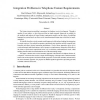Free Online Productivity Tools
i2Speak
i2Symbol
i2OCR
iTex2Img
iWeb2Print
iWeb2Shot
i2Type
iPdf2Split
iPdf2Merge
i2Bopomofo
i2Arabic
i2Style
i2Image
i2PDF
iLatex2Rtf
Sci2ools
98
Voted
IFM
1999
Springer
1999
Springer
Integration Problems in Telephone Feature Requirements
The feature interaction problem is prominent in telephone service development. Through a number of case studies, we have discovered that no single semantic framework is suitable for the synthesis and analysis of formal feature requirements models, and the choice of modelling language has certain knock-on effects on the transformational design steps which lead to implementation. We initially describe a mixed semantic model approach whilst acknowledging that integration is a major concern. Our method incorporates operational state transition models, temporal logic formulae and object oriented structuring mechanisms. Each of these approaches gives rise to certain advantages and disadvantages, and we propose a complementary integration which allows the client to express their requirements in the way in which they understand their needs, whilst building formal models for transformation and verification during design. This paper evaluates such a mixed semantic approach in the domain of tel...
Related Content
| Added | 04 Aug 2010 |
| Updated | 04 Aug 2010 |
| Type | Conference |
| Year | 1999 |
| Where | IFM |
| Authors | J. Paul Gibson, Geoff Hamilton, Dominique Méry |
Comments (0)

